Graham Reid | | 12 min read
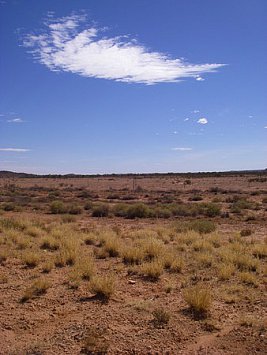
On a hot and cloudless morning in the arid Outback, Doug taxies his single-engine Cessna onto the rocky runway at Arkaroola, a strip of man-made flatland some 500kms north of Adelaide.
He makes a routine safety check, kicks the plane into fast-forward and we rise into a blazing blue sky, looking down on a parched landscape of scrub and dusty earth. The waterless creeks beneath us are merely shallow scribbles in the pale brown parchment-like land below. Lake Frome gleaming white near the horizon is an enormous stretch of salt so vast it is visible from space.
"NASA use it to calibrate colour on their imaging, they can see what white is", says Doug. And he's serious.
We bank across this primeval land. Scarred mountains drop into deep gorges and the little water we can see, and it is very little, looks black.
"Tannin, from gum leaves," says Doug. "Tastes a bit like tea."
He circles above his home, the Arkaroola Wilderness Sanctuary, then aims the aircraft due north. We are soon over the Tirari Desert where low vegetation coils and spirals like mysterious Aboriginal paintings. Animal tracks spindle to empty waterholes.
But surprisingly, given the remoteness of this place, Man’s presence is everywhere: the curving forms of Nature are cross-crossed by uncompromisingly straight tracks from four-wheel drive vehicles, pipelines and survey routes. From up here the immeasurable land seems full of invisible life.
Doug points out the two-metre high dog fence that runs 5300kms across Australia and the stone-covered gibber country which looks dark and forbidding.
It is hot in the cockpit -- on the ground it is in the high 30s -- and I feel a thirst coming on.
Just as well we're going for a beer at the Mungerannie Hotel. It’s only 250 kilometres away.
There are offers you can’t refuse. And a pub crawl through the Australian Outback -- most of it by small plane flying low over this magnificent, scorched landscape -- is one of them. But the Great Aussie Outback Pub Crawl -- one of a number of innovative Australian tours put together by Banksia Adventures -- proves to be much more than dropping in for beer at remote pubs however. The often terrifyingly dramatic land quickly becomes the attraction in itself: endless flatness peppered by small trees struggling for life; snakes, emus, camels, wallabies, kangaroos and goannas; and immense salt lakes with geometrical white patterns which contrast sharply with the abstract, pale brown or red land shaped by Antarctic winds eons ago.
And tyre tracks scored into the desert sands which makes you wonder, "Who?" And, "Why?"
We are a small party in Doug‘s plane: just the photographer Greg and myself; and Rolf, a tall, skinny and angular Swiss guy who possesses an unhappy ability to bang his shaven head against any low doorway.
Four days, three nights, and pubs as remote from the world as you could imagine.
At the Innamincka Hotel near where Burke and Wills met their dehydrated end I ask a guy at the bar where the nearest traffic lights are.
"About 600kms, in Port Augusta. Some of the boys drive down to have a look from time to time."
The Outback comes with its own humour, and it too is tinder dry.
The buttery golden sunset on our first night at the Prairie Hotel some 350kms north of Adelaide is spectacular. Those drinking outside the tiny pub walk across the dusty road to the desiccated fields to watch it in silence.
Then it is back into the pub's rustic dining room for more Fargher’s lager (named for the owner Jane Fargher) and the feral antipasto of smoked kangaroo, camel mettwurst, emu pate and goats cheese which comes with a bush tomato chutney. This is our first taste of the Outback -- and it is delicious.
It has been a long day since we left Adelaide. The first part of our journey up to Arkaroola to meet our pilot Doug is with Mick, our driver who is an erudite but earthy guide, and has a deep respect for the bush and those who have lived in it. He delivers an amusing and informative commentary on the drive up country (at Bolivar he notes they built the caravan park and motel adjacent to the sewage pond) and describes Yacka as "the deadest town in the world, I’ve never seen anyone outside in all the years I’ve passed through". And sure enough . . .
After the vineyards of the fertile Clare Valley the landscape changes: now there are few houses and spindly mally trees are scattered across the rolling plains. Brown dust coils into the still air, and only 90 minutes out from the sophistication of Adelaide -- "more cafes and restaurants per head of population than any other city in Australia" -- there is not another car on the burning bitumen.
The road ribbons out before us in the heat.
"This is the driest state in the driest continent in the world", says Mick -- and evidence of the current two year drought is all around us.
After our first official beer stop at the historic but much renovated Northstar Hotel in Melrose the earth becomes parched beyond belief.
"This is the land of nowhere," says Rolf gazing at trees which have perished because of too much salinity in the soil. Yet the land possesses an eerie beauty, the gum creeks where old trees mark what was once a riverbed become landmarks. European placenames are fewer, Aboriginal ones take over. Rock gives way to sand.
The scale of everything is different out here: the size of the stations is now measured in thousands of square kilometres; the coal train that passes through is 2.5kms long. Things get bigger -- and smaller. In the late afternoon we pass through Hawker, population 490. But it is huge compared with Blinman where we spend the night after our feral feed at the Prairie Hotel.
"You get anything out of Tony?" asks Mick with a laugh.
He's seen me talking to the Blinman Hotel’s manager. Tony’s contribution is monosyllables delivered through lips which barely move. I ask the population of Blinman.
"Fifteen."
"And the greater Blinman area?" I joke.
"Twenty-two."
After a long pause he tells me when they hold their Great Outback Cook-off competition they pull 1500 for a couple of days of drinking and eating.
"That means the local population is out-numbered by 100-to-one?"
"That's right," and he wanders off for a cigarette.
Outside of Blinman at the cemetery a big red roo watches us walk around the graves of local pioneers who, if they lived past their first year, made it into their 80s and 90s. Just past here the sealed road ends.
On our way to Arkaroola Mick pulls over beneath the red gums so we can stretch our legs. I wander down to the waterless creek bed. It is unexpectedly silent, no birds or flies. Bleached branches of the gums arch overhead, the cracked earth beneath creates hypnotic abstract patterns. I feel, for the first time, that this dry land is astonishingly attractive and can understand its pull on people.
"The best thing about this country," Mick says as we drive on, "is you're not allocated a campsite."
A kangaroo hops out of the heat on the roadway before us. Arkaroola lies somewhere beyond the horizon and the haze.
The Arkaroola Wilderness Sanctuary is rich in history. As Doug -- the son of its famous founder Reg Sprigg -- points out, some of these mountains here were once beneath the sea and are 500 million years old. Doug's late father Reg -- a geologist, zoologist, surveyor, pioneering oceanographer, businessman, ecologist, and the man who discovered the world's oldest fossil animals in 1947 -- purchased the 61,000 hectare Arkaroola sheep station in 1967, removed the stock and turned it into a wildlife sanctuary. Visitors and geology students come from all over the world, and in the hills nearby are observatories.
Doug -- whose quick mind often outpaces his tongue -- has inherited his father's diverse interests and his energetic conversation shifts from botany to engineering seamlessly. He is a remarkable, witty character and is to be our pilot-cum-commentator for the next two days.
But first we bounce across the ridge tops of Arkaroola on a flatbed truck ("the enamel camel" says Mick) for a four-hour journey with ginger-haired Ryan who points out geological items of interest. We stop for tea and Lamington cakes at Sillers Lookout where the view back to the Freeling Range and down to the plains is as vast as the Grand Canyon. It is a bone-shaking journey during which we see camels, emus ("turbo chooks"), some yellow-footed rock wallabies, and more rocks and dust than you need in a lifetime. The track redefines "unsealed" and laughs at the word "road".
Ryan and I are talking at the barbecue that night. He's recently back from Birdsville with nine camels on a 33 day journey. He had some tourists with him for the first 16 days but after that . . .
So is a camel comfortable to ride?
"Aw, you don't ride 'em, you walk beside 'em. They carry your packs and gear."
You walked 33 days through this country?
"Yeah."
I go off for another beer. This takes some thinking about.
The following morning Mick drives eight hours back to Adelaide and we fly off with Doug to start our aerial pub crawl. First stop, the Mungerannie Hotel beside the Birdsville Track, a 520km former cattle trail from the Northern Territory which is now an unsealed road through the desert.
Despite its isolation the pub gets 45,000 visitors a year because it is halfway between Birdsville and Maree.
"Basically because there's bugger all else out here," says the manager John -- with a long white beard and exceptionally clear eyes -- who has picked us up in his ute from the stony tarmac. Inside the pub black burns scored deep in the floorboards are evidence of where some guys tied three Harleys to the bar and did wheelies. People make their own amusement in such dusty and dry places.
The pub's ceiling is covered by battered and autographed Akubra hats, and a sign announces "hangovers sold and serviced here". They do a seven course lunch: a six pack and a pie.
John says one day he'll quit being a publican, "going to get me one of them part time jobs. You know, 40 hours a week." He's thinking of getting a property "overlooking the water".
Outside, past some abandoned trucks and beyond a line of trees, rare in this part of the desert, is something utterly unexpected: the Derwent River which attracts over a hundred species of deafening birds. There's also a hot pool fed by artesian water. Greg and I share the feeling that just beyond the white sand dunes there could be a beach. Probably the same kind of deluded thinking that kept explorers going through this sun-burned land.
We finish another beer, I buy a tasteful cooler in the shape of woman’s bikini-clad body, and John takes us back to the plane. We're going for a chaser at "the neighbours", the Innamincka Hotel about 200kms across the Sturt Stony Desert. Beneath us semi-trailers at remote mining camps look like matchsticks in a sandpit.
Phyl gives us hearty handshakes and a tour of the town which takes minutes so we are soon at the Innamincka Hotel which has a beer garden -- covered, of course -- called the Outer-Mincka. Behind the bar -- where locals have their named coolers stored -- Don says he came up here only recently and loves it. "Always just busy enough."
After a couple of beers I look at the photos of sandstorms, droughts and flooding on the walls, then find myself flicking coins into a large vat on the top shelf behind the bar, all contributions going to the Flying Doctor. A truckie asks where we’re headed and I tell him Birdsville, about 220kms north.
"You’ll like it up there, it's real quiet."
This from a man whose just told me the nearest cop-shop is 550kms away?
On the wall is a wooden plaque: 10th annual OPTSPU.
"The Outback Publicans Tri-State Piss Up," says Phyl. "It’s a conference."
On another hot and cloudless morning we are standing by Doug’s plane parked across from the iconic Birdsville Hotel.
"Well," says Rolf, his shaven head gleaming in the sun, "I have stayed at the Birdsville Hotel. I cannot say this was a childhood dream of mine . . ."
The Birdsville Hotel -- built in 1884 -- is legendary for its isolation, and hospitality. The outdoor bar has a barbecue the size of a pool table. We have, as the saying goes, given it a nudge the night before, talked water and the lack of it, and eaten enormous and cheap meals. A poster on the pub wall says "Beer is your friend". But not today. At a hangover breakfast the radio plays Who’ll Stop the Rain. Outside it is a blistering 39 degrees.
As Doug refuels the pub's owner Kym -- his wraparound sunglasses bisected horizontally by the reflection of the blue sky and the dark gravel of the tarmac -- tells how he came here 27 years ago as a builder after the pub was gutted by a fire. Hasn't left.
Again we talk water and the lack of it.
"Greenest thing 'round here's your shirt," he says in the clipped speech of The Outback.
But that isn't entirely true because across from the pub is a healthy-looking grassy oval which we have seen when we flew in yesterday. It looked like a putting green in a sandtrap the size of Taranaki.
"I don’t think they've thought of a use for it yet," says Doug as we hum towards the endless Simpson Desert where he drops us down low. Three dromedaries gnaw at leaves on a small tree, and they are the only sign of life we see for hours. This is spectacularly beautiful world, best appreciated from a light plane where the expanse is apparent and the geographic features makes sense. We loop down past Lake Eyre where the salt is half a metre deep in places, and on to the William Creek Hotel. It is on the 5-million acre Anna Creek Homestead, a property bigger than Belgium.
We touch down near the hotel, established in 1887, now owned by Neville and his wife who have only been here five months.
"Nah, I don't feel isolated," he says. "You can pick up a phone and talk to anyone, and the Flying Doctor comes every fortnight."
We sip another lager and get pies of homemade emu, kangaroo curry, or lamb and river mint. The middle-aged couple at the bar have driven from Perth 3020kms away across areas labelled "unnamed conservation land". They’ve mostly been making their own roads. Outside it is 37 degrees, in a fenced-off area is a garden of rocket debris from nearby Woomera, and by the dirt road, laughably, a sign which warns of children crossing.
The Ghan railway once went through here, but not much does now. However everyone who has stopped at the pub has donated their business card, cap or some memorabilia to the colourfully crowded walls. A lot have signed the pool table. Neville talks water too: "People 'round here don’t drink much water. Bottled water? That's for city people," he says dismissively. I ask what they do to prevent dehydration and he looks at the beer in my hand.
We sink our drinks and walk back to the plane. As I cross the road I automatically look for traffic. Ha!
After an hour -- across the dog fence again and once more above desert with scribbles of tyre tracks between mining camps -- Doug indicates a dark patch in the distance; "The Andamooka opal fields. If it's not then we're lost."
Andamooka is a strange, outlaw town. Erica who meets us says the streets have no names and if an address is required for an official document everyone just gives a made-up number on "Government Road".
"There’s no Government Road, if there was there'd be hundreds living on it."
She also says most of the 300 to 400 permanent residents go by nicknames, so you really know nothing of someone's past.
She shows us some of the old opal miners' houses from the Thirties, tiny affairs, then takes us out to her dig.
People here tunnel into the ground searching for veins of opals -- which accounts for the surreal humps of white and red dirt which encircle the town. Her husband Jerry invites us into his crawl space dozens of metres below the ground where he is working with a jack-hammer and using a black light to identify the uncut opals.
He shows me a chunk: "That's worth about $1500."
But their main tunnels are wide, high and there is a sense of spaciousness down here. Erica and Jerry have a room with a fridge, two comfortable chairs and small table. They bring the laptop down and watch DVDs. They sleep down here sometimes. Jerry displays some of the beautiful polished opals he has mounted in hand-made gold-frames. They are exceptional and tasteful, and we‘re not surprised to hear he has 300 places in Germany alone which take his work. An hour later we emerge from the mine like moles blinking into the blinding afternoon.
"Some days we come up, and just go back down again," says Erica.
Rolf and I nod at each other as we squint into the hard light.
"But this is strange," whispers Rolf as we melt in the sun. "They are . . . underground people?"
Jerry drives us back to the rough runway through a moonscape of craters and mounds. We are glad to have seen this, but also bewildered by this remote, subterranean life.
Doug taxies along the red and rocky runway. Before us are hours of parched plains, the salty whiteness of Lake Torrens, fly-infested Port Pirie to refuel and then, after the earth has becomes green and fertile again, we'll be back in the crowded streets of Adelaide. It is another hot and cloudless day in the arid, inexplicably beautiful, Outback.
By sunset we’ll have flown more than 1000kms from Birdsville -- and we’ll need a beer.

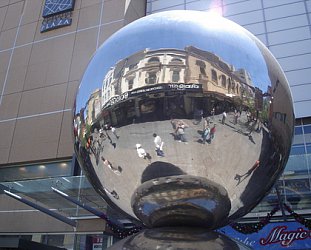
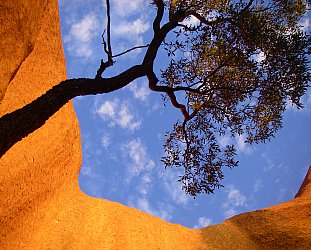
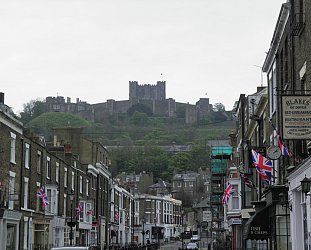

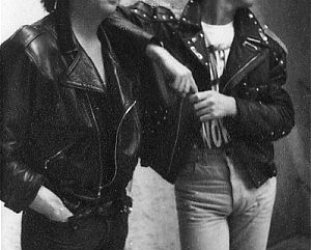
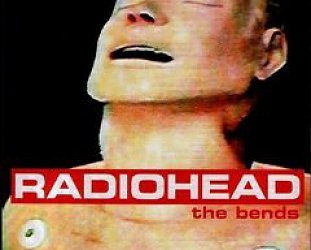
post a comment